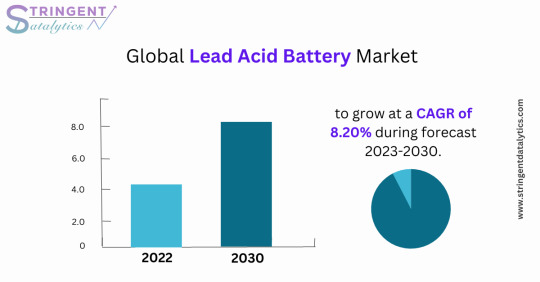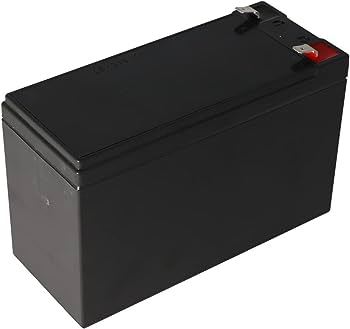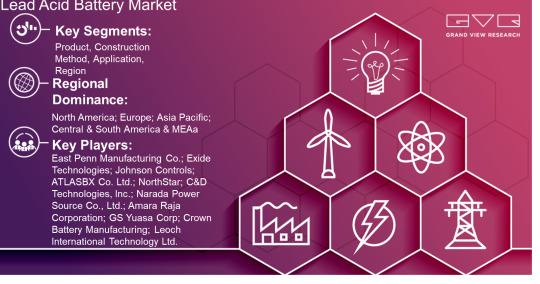#Lead Acid Battery Market
Text
Understanding the Chemistry Behind Lead-Acid Batteries

Lead-acid batteries have long been the backbone of automotive power solutions, providing reliable and cost-effective energy storage for vehicles of all types. As one of the leading car battery suppliers, Vacuna is dedicated to unraveling the chemistry that powers these essential components. Let’s delve into the intricate chemistry of lead-acid batteries, their working principle, and diverse applications in the automotive industry.
What is a Lead-Acid Battery?
A lead-acid battery is a type of rechargeable battery that utilizes lead plates immersed in an electrolyte solution of sulfuric acid to store and release electrical energy. These batteries are commonly used in vehicles, uninterruptible power supplies (UPS), and other applications requiring reliable energy storage.
Working Principle of Lead-Acid Battery
The working principle of a lead-acid battery involves electrochemical reactions that occur within its cells during charging and discharging cycles. When the battery is charged, electrical energy is converted into chemical energy, causing lead dioxide (PbO2) to form on the positive plate and lead (Pb) to form on the negative plate. This process reverses during discharge, with lead dioxide converting back to lead sulfate (PbSO4) and releasing electrical energy.
Chemistry of Lead-Acid Battery
The chemistry of a lead-acid battery revolves around the following key reactions:
1. Charging Reaction (Positive Plate):
PbO2 + H2SO4 + 2H+ + 2e– → PbSO4 + 2H2O
Lead dioxide, sulfuric acid, and hydrogen ions combine to form lead sulfate and water during charging.
2. Discharging Reaction (Positive Plate):
PbSO4 + 2H2O → PbO2 + H2SO4 + 2H+ + 2e–
Lead sulfate reacts with water to regenerate lead dioxide, sulfuric acid, and release hydrogen ions and electrons during discharge.
3. Charging Reaction (Negative Plate):
Pb + HSO4– → PbSO4 + H+ + 2e–
Lead reacts with bisulfate ions to form lead sulfate, releasing hydrogen ions and electrons.
4. Discharging Reaction (Negative Plate):
PbSO4 + H+ + 2e– → Pb + HSO4–
Lead sulfate is reduced back to lead and bisulfate ions during discharge.
Application of Lead-Acid Battery
Lead-acid batteries find widespread application in the automotive industry, powering vehicles ranging from cars and trucks to motorcycles and recreational vehicles. Lead-acid batteries are engineered to meet the stringent power requirements of modern vehicles, including start-stop systems, advanced electronics, and energy-intensive accessories. They also serve as reliable backup power sources for critical automotive systems, ensuring uninterrupted performance in various driving conditions.
Advantages of Lead-Acid Battery
Cost-Effective: Lead-acid batteries are relatively affordable compared to other types of batteries, making them a cost-effective choice for a wide range of applications, including automotive use.
Proven Technology: Lead-acid batteries have been in use for decades and have a well-established track record of reliability and performance, instilling confidence in their use for critical applications.
High Energy Density: Lead-acid batteries offer a high energy density, providing ample power storage in a compact and efficient package, making them suitable for vehicles with limited space.
Low Self-Discharge Rate: Lead-acid batteries have a low self-discharge rate, meaning they can retain their charge for extended periods, making them ideal for backup power applications.
Recyclable: Lead-acid batteries are highly recyclable, with a significant portion of the materials used in their construction being recoverable and reusable, contributing to environmental sustainability.
In conclusion, Vacuna’s expertise as a car battery supplier extends to understanding the intricate chemistry of lead-acid batteries and harnessing this knowledge to deliver high-quality power solutions. With their proven performance, durability, and cost-effectiveness, lead-acid batteries continue to play a crucial role in powering vehicles and supporting automotive operations worldwide. Trust Vacuna as your reliable partner for automotive power solutions.
0 notes
Text
Lead Acid Battery Market is anticipated display a CAGR of around ~5% over the forecast period (2021-2027)
0 notes
Text
Introduction to Lead-Acid Batteries: Components and Design

Lead-acid batteries have been a trusted source of power for over a century, offering dependable energy storage and delivery in a range of applications, from automotive to renewable energy systems. Understanding the construction and design of lead-acid batteries is essential for gaining insight into their performance and potential use cases. In this blog, we will discuss the construction and design of lead-acid batteries in detail.
Lead-Acid Battery Construction
Lead-acid batteries are composed of several key components that work together to create an efficient and durable energy source:
1. Plates:
The heart of the lead-acid battery consists of two types of plates: positive plates made of lead dioxide (PbO₂) and negative plates composed of sponge lead (Pb). These plates act as electrodes, engaging in electrochemical reactions that generate electricity.
2. Electrolyte:
The battery's electrolyte is a solution of sulfuric acid (H₂SO₄) and water, which enables the flow of ions between the positive and negative plates. This fluid is critical for the chemical reactions that produce electrical energy.
3. Separators:
Separators, typically made of porous polymer material, keep the positive and negative plates apart to prevent short circuits. These components allow ions to pass through while maintaining electrical insulation between the plates.
4. Container:
The battery is housed in a durable, impact-resistant container, often made of polypropylene, which protects the internal components and prevents electrolyte leakage.
5. Terminals:
The battery features two terminals, positive and negative, which connect the battery's internal components to external circuits. These terminals allow electricity to flow from the battery to power devices.
Design of Lead-Acid Batteries
Lead-acid batteries come in various designs, each tailored for specific applications and performance requirements:
1. Flooded (Wet-Cell) Lead-Acid Batteries:
Flooded lead-acid batteries, also known as wet-cell batteries, are the most common type and feature a liquid electrolyte that freely moves around the plates. They require regular maintenance, such as checking and replenishing the electrolyte levels. Flooded batteries offer high current delivery and are often used in automotive and deep-cycle applications.
2. Absorbed Glass Mat (AGM) Batteries:
AGM batteries use a glass fiber mat to absorb the electrolyte and keep it in place. This design makes AGM batteries spill-proof, maintenance-free, and suitable for use in any orientation. They have lower internal resistance and provide efficient power delivery, making them ideal for high-performance applications such as start-stop systems in vehicles and backup power.
3. Gel Lead-Acid Batteries:
Gel lead-acid batteries contain a gel-like electrolyte that immobilizes the acid, preventing leaks and enabling the battery to be maintenance-free. Gel batteries offer deep-cycle capabilities and are suitable for applications that require a reliable power source, such as marine, recreational vehicles, and off-grid energy storage.
Conclusion
Lead-acid batteries continue to play a crucial role in providing reliable and cost-effective energy storage in a variety of applications. Understanding the construction and design of these batteries helps you select the right type for your specific needs and maintain them properly for optimal performance and longevity. Whether you choose flooded, AGM, or gel lead-acid batteries, each design offers unique advantages for different use cases. Selecting the appropriate battery type ensures efficient energy storage, a dependable power source, and a long-lasting, cost-effective solution for your energy needs.
0 notes
Text
Lead Acid Battery
Lead Acid Battery market

0 notes
Text
Global Lead Acid Battery Market Is Estimated To Witness High Growth Owing To Increasing Demand for Renewable Energy Storage Solutions

A) Market Overview:
Lead Acid Batteries are rechargeable batteries widely used in various applications such as automotive, renewable energy storage, and UPS systems. These batteries are known for their low cost, high energy density, and reliability. The market for lead acid batteries is witnessing significant growth due to the increasing demand for renewable energy storage solutions and the growing automotive industry.
B) Market Key Trends:
The key trend driving the growth of the global Lead Acid Battery market is the surge in demand for renewable energy storage solutions. With the increasing use of renewable energy sources such as solar and wind power, the need for efficient energy storage systems has also risen. Lead acid batteries offer a cost-effective solution for storing renewable energy. These batteries can store excess energy during low-demand periods and supply it during peak demand, thereby ensuring a stable power supply. For instance, Tesla's South Australia Powerpack Project, a massive energy storage facility, utilizes lead-acid batteries to store renewable energy generated from wind farms.
The global Lead Acid Battery Market Size is estimated to be valued at US$ 47.5 Bn in 2021 and is expected to exhibit a CAGR of 8.2% over the forecast period 2022-2030, as highlighted in a new report published by Coherent Market Insights.
C) PEST Analysis:
Political: The political landscape plays a crucial role in shaping the lead acid battery market. Government policies and regulations regarding the use of lead acid batteries in automotive and renewable energy sectors can impact the market growth.
Economic: Economic factors such as GDP growth, disposable income, and consumer spending patterns influence the demand for lead acid batteries.
Social: The growing awareness about the need for sustainable energy solutions and the increasing adoption of electric vehicles contribute to the demand for lead acid batteries.
Technological: Technological advancements in battery technology, such as improvements in efficiency, lifespan, and charging capabilities, drive innovation in the lead acid battery market.
D) Key Takeaways:
The global Lead Acid Battery market is expected to witness high growth, exhibiting a CAGR of 8.2% over the forecast period, due to the increasing demand for renewable energy storage solutions. Lead acid batteries provide an efficient and cost-effective solution for storing excess renewable energy.
In terms of regional analysis, Asia Pacific is the fastest-growing and dominating region in the lead acid battery market. The region is witnessing rapid industrialization and urbanization, leading to an increased demand for reliable power supply systems. Additionally, the automotive industry in countries like China and India is thriving, further driving the demand for lead-acid batteries.
Key players operating in the global Lead Acid Battery market include Johnson Controls, ATLASBX Co. Ltd., Exide Technologies, East Penn Manufacturing Co, Crown Battery Manufacturing Company, C&D Technologies INC., GS Yuasa Company, Leoch International Technology Ltd., Chaowei Power Holdings Limited, and Camel Group Co. Ltd., Hoppecke Batterien GmbH & Co. KG. These players are focusing on product innovations, partnerships, and acquisitions to strengthen their market presence.
In conclusion, the global Lead Acid Battery market is expected to witness significant growth in the coming years due to the increasing demand for renewable energy storage solutions. The market is driven by factors such as government initiatives for clean energy adoption and the growing automotive industry. Asia Pacific is anticipated to be the fastest-growing region in the market, with key players actively participating in product development and acquisitions to gain a competitive edge.
#Lead Acid Battery Market#Lead Acid Battery Market Size#Coherent Market Insights#Lead Acid Battery Market Demand#Lead Acid Battery Market Growth#Lead Acid Battery Market Analysis#Lead Acid Battery Market Trends#Lead Acid Battery Market Forecast
0 notes
Text
Lead Acid Battery Market Outlook On The Basis Of Product, Construction Method, Application, Region And Forecast From 2023 to 2030
San Francisco, 27 June 2023: The Report Lead Acid Battery Market Size, Share & Trends Analysis Report By Product (SLI, Stationary, Motive), By Construction Method (Flooded, VRLA), By Application, By Region, And Segment Forecasts, 2023 – 2030
The global lead acid battery market size is expected to reach USD 55.23 billion by 2030, according to a new report by Grand View Research, Inc. The market…

View On WordPress
#Lead Acid Battery Industry#Lead Acid Battery Market#Lead Acid Battery Market 2023#Lead Acid Battery Market 2030#Lead Acid Battery Market Revenue#Lead Acid Battery Market Share#Lead Acid Battery Market Size
0 notes
Link
#market research future#lead acid battery market#lead acid battery industry#lead acid battery#lead acid battery market size
0 notes
Link
The global lead acid battery market is projected to reach USD 52.5 billion by 2024 from an estimated USD 41.6 billion in 2019, at a CAGR of 4.7% during the forecast period. This growth can be attributed to factors such as the need to integrate renewable energy to the main grid, and the booming data industry promising the installation of several data centers across the globe, which expects the utilization of lead acid batteries for backup power supply.
0 notes
Link
#market research future#lead acid battery market#lead acid battery industry#lead acid battery#lead acid battery market size
0 notes
Text
Valve Regulated Lead Acid (VRLA) Batteries Market Growth Strategies: Unraveling Opportunities in E-Mobility and Grid Support

The Valve Regulated Lead Acid (VRLA) batteries market is a segment within the broader battery industry, characterized by batteries that are sealed and do not require regular maintenance. These batteries are designed with a valve mechanism that regulates the internal pressure, preventing the release of gases and allowing for recombination of hydrogen and oxygen. VRLA batteries find applications in various industries, including telecommunications, uninterruptible power supply (UPS) systems, and renewable energy storage.
The market overview and scope of VRLA batteries encompass their use in providing backup power in critical systems where reliability is paramount. With advancements in technology, VRLA batteries have become increasingly popular due to their maintenance-free operation and versatility in different environments. The scope of the market extends to sectors where uninterrupted power supply is crucial, driving the demand for reliable energy storage solutions.
Valve Regulated Lead Acid (VRLA) batteries market growth segment is influenced by factors such as the expanding telecommunications industry, the rise in demand for clean energy solutions, and the growing need for backup power in various applications. As industries and consumers alike prioritize sustainable practices, VRLA batteries present an environmentally friendly option compared to traditional lead-acid batteries.
The market industry for VRLA batteries is competitive and dynamic, with key players constantly innovating to enhance battery performance, durability, and efficiency. Manufacturers focus on research and development to introduce new technologies that address the evolving needs of end-users. Additionally, strategic collaborations and partnerships in the supply chain contribute to the overall growth and development of the VRLA batteries market.
Trends in the VRLA batteries market reflect the industry's response to the increasing demand for energy storage solutions. This includes the integration of smart technologies for remote monitoring, predictive maintenance, and improved energy management. Moreover, the market is witnessing a shift towards enhanced energy density and longer cycle life, aligning with the global push towards sustainable and resilient power systems.
In conclusion, the Valve Regulated Lead Acid (VRLA) batteries market is a dynamic sector within the broader battery industry. With a focus on reliability, sustainability, and technological advancements, the market continues to evolve to meet the growing demand for energy storage solutions across various applications.
#Valve Regulated Lead Acid (VRLA) Batteries Market#Valve Regulated Lead Acid (VRLA) Batteries Market Growth#Valve Regulated Lead Acid (VRLA) Batteries Market Trends
0 notes
Text
Order 3: 3*40 HQ Battery Container Coming
High Quality Battery Container and Customer with Good Reputation will have Huge Market of Batteries.

View On WordPress
0 notes
Text
The global advanced lead acid battery market revenue surpassed USD 25.91 billion in 2022 and is estimated to reach around USD 57.98 billion by 2032, growing at a healthy CAGR of 8.39% from 2023 to 2032.
0 notes
Text
India E-Rickshaw Lead Acid battery market size in terms of Volume will grow from 615.8 thousand units in FY2022 to 10,129.76 thousand units by FY2030, at a CAGR of 38.86% during forecast period.
0 notes
Text
Lead Acid Battery for ESS
Lead Acid Battery for ESS market

0 notes